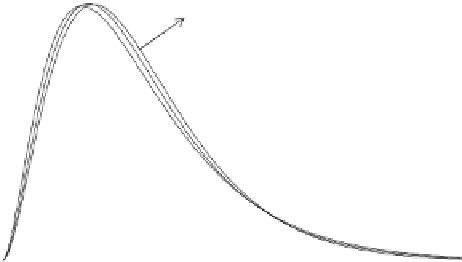Geoscience Reference
In-Depth Information
0.3
1
Ku
2
0.2
3
0.1
0
0
10
2
4
6
8
t/K
Fig. 12.22 Dimensionless unit response function
Ku
(
t
/
K
) of a cascade of three storage elements (1) with
equal storage coefficients
K
, as given by Equation (12.41) with
n
=
3 or Equation (12.39), (2) with
unequal storage coefficients, namely Equation (12.45) with
K
1
=
K
2
=
0
.
75
K
and
K
3
=
1
.
5
K
, and
(3) with unequal storage coefficients, namely Equation (12.45) with
K
1
=
0
.
4
,
K
2
=
1
.
0
K
and
K
3
=
1
.
6
K
.
In the same way, for
n
=
3 tanks, with three different storage coefficients
K
1
,
K
2
and
K
3
,
instead of Equation (12.39), one obtains the following expression
K
1
[exp(
−
t
/
K
1
)
−
exp(
−
t
/
K
3
)]
K
2
[exp(
−
t
/
K
2
)
−
exp(
−
t
/
K
3
)]
u
3
(
t
)
=
−
(
K
1
−
K
2
)(
K
1
−
K
3
)
(
K
1
−
K
2
)(
K
2
−
K
3
)
(12.45)
This process can be continued for any number of tanks. For
n
3 as an example,
Figure 12.22 shows a comparison between Equations (12.39) and (12.45) with
K
1
=
K
2
=
=
6
K
; the main
point is that the difference between these response functions is not very large, because
the total lag time, that is the first moment
m
u
1
has been kept the same in all three cases,
such that
K
1
+
3
K
/
4,
K
3
=
3
K
/
2 and also with
K
1
=
0
.
4
K
,
K
2
=
K
,
K
3
=
1
.
3
K
(cf. Equation (12.42)). The agreement would have been
even better, if also the second moment had been kept the same in all three cases. This
calculation illustrates why the passage of rain water through a succession of storage
elements, such as interception and detention, soil moisture and groundwater, overland
and channel flows, may still be described reasonably well by Equation (12.41), even
though each one of these storage elements may have a different storage coefficient
K
.
K
2
+
K
3
=
Stochastic interpretations
Several of the above response functions, as combinations of storage tanks with or with-
out linear channels, have been used with good results in the solution of a number of
engineering problems. In some of these studies of specific catchment situations, ad hoc
empirical relationships were derived for the parameters in these runoff representations.


















































































